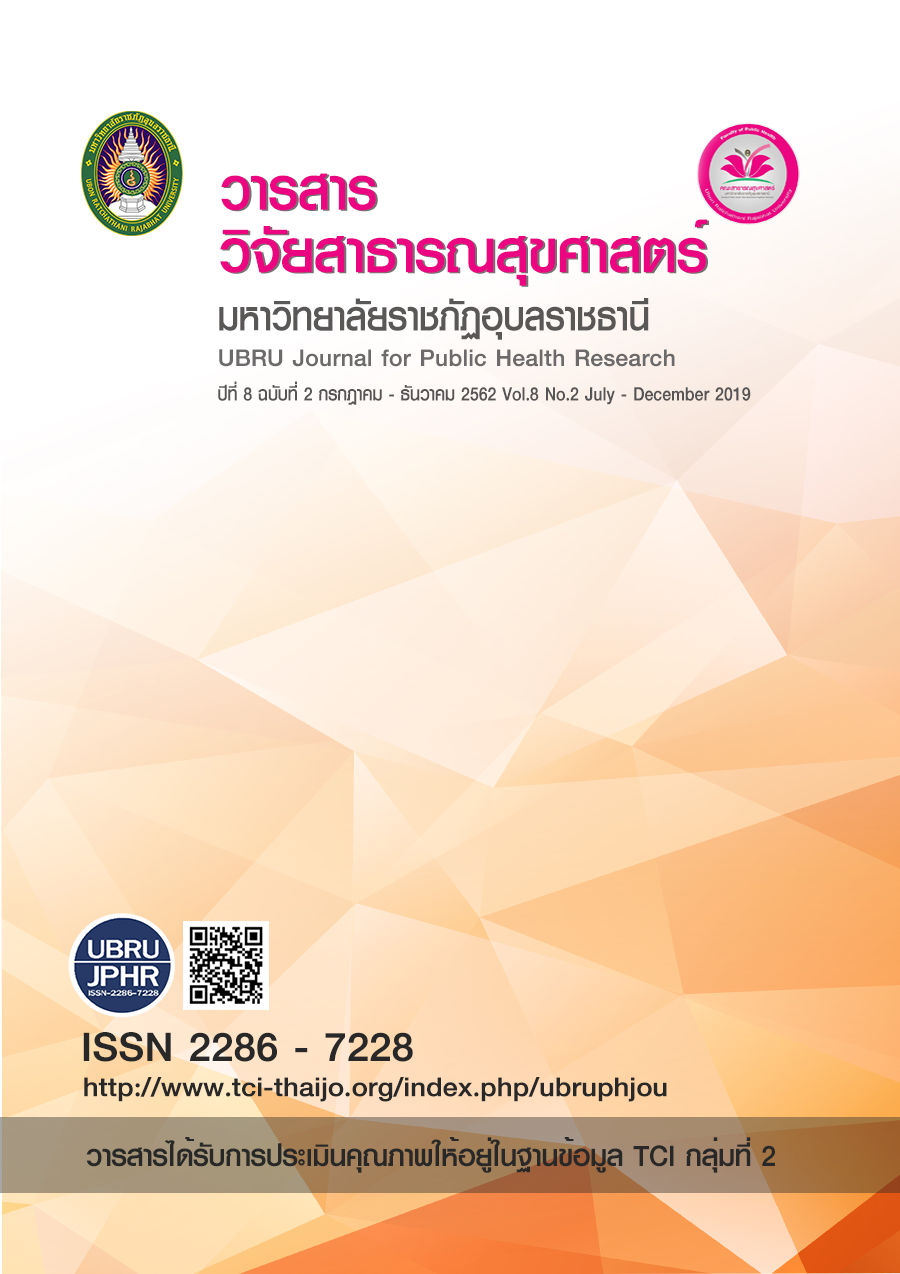Prevalence and risk behaviors of Opisthorchis viverrini reinfection of people in Sisaket Province
Keywords:
Prevalence, risk behaviors, Opisthorchis viverrini reinfectionAbstract
Clonorchis sinensis and Opisthorchis viverrini are still public health problems in East Asia and Southeast Asia. Thailand is one of the areas where many patients with Opisthorchis viverrini infection are found, especially in the Northeast. Most importantly, Opisthorchis viverrini infection is the main cause of cholangiocarcinoma. Opisthorchis viverrini reinfection increases the risk of cholangiocarcinoma. The study of prevalence and risk behaviors of Opisthorchis viverrini reinfection, therefore, is important for assessing the situation of the spread of the disease and recognizing the causes of the risk behaviors of Opisthorchis viverrini infection in the area. The results of this study can also be used in the planning of public health operations.
This was a cross-sectional study which aimed to study the prevalence and the risk behaviors of Opisthorchis viverrini reinfection of people in Sisaket Province. The samples were selected by multi-stage sampling method. They were 68 people in the responsibility area of Thung Chai Health Promoting Hospital and Hua Chang Health Promoting Hospital, Uthumphon Phisai District, Sisaket Province. All of them had been detected with liver fluke eggs in the stool, confirmed by the public health authorities using the Kato's Thick Smear. The data were collected by the questionnaire on risk behaviors of Opisthorchis viverrini reinfection of people in Sisaket Province. Descriptive statistics, including frequency, percentage, mean and standard deviation were employed for data analysis.
The research revealed that the samples’ rate of Opisthorchis viverrini reinfection was 16.18%. The results of the risk behaviors of Opisthorchis viverrini reinfection showed that the score of practices of most of the samples was at a moderate level, accounted for 45.59%. The risk behaviors of Opisthorchis viverrini reinfection of the samples included eating papaya salad with uncooked fermented fish sauce, eating chili paste with uncooked fermented fish sauce and eating uncooked or half-cooked Plasom (soured fermented fish). However, the behavior of defecation outside the toilet was not much found.
References
กระทรวงสาธารณสุข, กรมควบคุมโรค. (2555). คู่มือกำจัดโรคพยาธิใบไม้ตับสำหรับประชาชน. นนทบุรี: สำนักโรคติดต่อทั่วไป.
กระทรวงสาธารณสุข, สำนักงานหลักประกันสุขภาพแห่งชาติ. (2555). แผนยุทธศาสตร์ลดพยาธิใบไม้ตับกำจัดมะเร็งท่อน้ำดีวาระคนอีสาน. นนทบุรี: สำนักงานหลักประกันสุขภาพแห่งชาติ.
ณรงค์ ขันตีแก้ว. (2556). มะเร็งตับและท่อน้ำดี. อุบลราชธานี: อุบลกิจออฟเซทการพิมพ์.
บรรจบ ศรีภา, พวงรัตน์ ยงวณิชย์ และชวลิต ไพโรจน์กุล. (2548). สาเหตุและกลไกการเกิดโรคมะเร็งท่อน้ำดีปฐมบทความสัมพันธ์กับพยาธิใบไม้ตับ. ศรีนครินทร์เวชสาร. 20(3), 123-131.
สำนักงานสาธารณสุขจังหวัดศรีสะเกษ, กลุ่มงานควบคุมโรค. (2559). สถานการณ์และการดำเนินงานเพื่อแก้ไขปัญหาพยาธิใบไม้ตับและมะเร็งท่อน้ำดีจังหวัดศรีสะเกษ ปี 2559. [ออนไลน์]. ได้จาก https://www.ssko.moph.go.th/news2/details.php?id=2623. [สืบค้นเมื่อ 1 เมษายน 2560]
สำนักงานสาธารณสุขจังหวัดศรีสะเกษ, กลุ่มงานพัฒนายุทธศาสตร์ (2560). ตัวชี้วัดงานป้องกันควบคุมโรคหนอนพยาธิจังหวัดศรีสะเกษ ปี 2560. [ออนไลน์]. ได้จาก https://www.ssko.moph.go.th/news2/details.php?id=2729. [สืบค้นเมื่อ 1 เมษายน 2560]
อภิชิต แสงปราชญ์. (2553). ปัจจัยที่มีความสัมพันธ์กับพฤติกรรมการป้องกันโรคมะเร็งตับและมะเร็งท่อน้ำดีของประชาชนจังหวัดอุบลราชธานี. วิทยานิพนธ์สาธารณสุขศาสตรมหาบัณฑิต สาขาวิชาการสร้างเสริมสุขภาพ มหาวิทยาลัยราชภัฎอุบลราชธานี.
อุรชา สีเหลือง. (2555). พฤติกรรมการป้องกันการรับประทานอาหารสุกๆ ดิบๆ ของประชาชนในจังหวัดอุบลราชธานี. วิทยานิพนธ์สาธารณสุข ศาสตรมหาบัณฑิต สาขาวิชาการสร้างเสริมสุขภาพ มหาวิทยาลัยราชภัฏอุบลราชธานี.
International Agency for Research on Cancer (1994). Infection with liver flukes. IARC monographs on the evaluation of carcinogenic risks to humans. 61, 121-162.
International Agency for Research on Cancer (2009). Opisthorchiasis viverrini and Clonorchis sinensis. Biological agents a review of human carcinogens. IARC monographs on the evaluation of carcinogenic risks to humans. 100B, 348-355.
Kamsa-ard S, Luvira V, Pugkhem A, Luvira V, Thinkhamrop B, Suwanrungruang K, et al. (2015). Association between praziquantel treatment and cholangiocarcinoma: a hospital-based matched case-control study. BMC Cancer. 15, 776.
Saengsawang P., Promthet S and Bradshaw P. (2016). Reinfection by Opisthorchis viverrini after treatment with praziquantel. Asian Pacific J Cancer Prev. 17, 857-862.
Songserm, N., Promthet, S., Sithithaworn, P., Pientong, C., Ekalaksananan, T., Chopjitt, P., et al. (2011). MTHFR polymorphisms and Opisthorchis viverrini infection: a relationship with increased susceptibility to cholangiocarcinoma in Thailand. Asian Pacific J Cancer Prev. 12, 1341-1345.
Songserm, N., Promthet, S., Sithithaworn, P., Pientong, C., Ekalaksananan, T., Chopjitt, P., et al. (2012). Risk factors for cholangiocarcinoma in high-risk area of Thailand: Role of lifestyle, diet and methylenetetrahydrofolate reductase polymorphisms. Cancer Epidemiol. 36, e89-94.
Downloads
Published
How to Cite
Issue
Section
License
เนื้อหาและข้อมูลในบทความที่ลงตีพิมพ์ในวารสารวารสารวิจัยสาธารณสุขศาสตร์ มหาวิทยาลัยราชภัฏอุบลราชธานี ถือเป็นข้อคิดเห็นและความรับผิดชอบของผู้เขียนบทความโดยตรงซึ่งกองบรรณาธิการวารสาร ไม่จำเป็นต้องเห็นด้วย หรือร่วมรับผิดชอบใดๆ
บทความ ข้อมูล เนื้อหา รูปภาพ ฯลฯ ที่ได้รับการตีพิมพ์ในวารสารนี้ ถือเป็นลิขสิทธิ์ของวารสารฯ หากบุคคลหรือหน่วยงานใดต้องการนำทั้งหมดหรือส่วนหนึ่งส่วนใดไปเผยแพร่ต่อหรือเพื่อกระทำการใดๆ จะต้องได้รับอนุญาตเป็นลายลักอักษรณ์จากบรรณาธิการวารสารนี้ก่อนเท่านั้น


